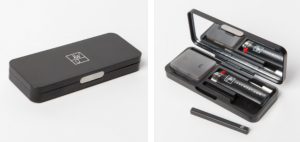The cannabis industry is a catalyst for innovation. Industry leaders keep the cannabis space on the cutting edge as companies encourage new developments in biotechnology, marketing, consumer goods and more.
Here are the areas to watch for cannabis industry developments in 2018.
1. Outside industries
 Industries outside the cannabis space are taking notice of opportunities to edge in – a huge talking point from MJBizCon 2017, where speaker Jeanne Sullivan told attendees “These companies are not going to miss out,” referring to the 2017 industry entrances of Scotts Miracle-Gro, liquor distributor Constellation Brands and Netflix.
Industries outside the cannabis space are taking notice of opportunities to edge in – a huge talking point from MJBizCon 2017, where speaker Jeanne Sullivan told attendees “These companies are not going to miss out,” referring to the 2017 industry entrances of Scotts Miracle-Gro, liquor distributor Constellation Brands and Netflix.
Beer and alcohol industry – American-based Constellation Brands, the firm behind major beer brands Corona and Modelo, purchased a 10 percent stake in Canadian cannabis giant Canopy Growth Corporation.
At a National Beer Wholesalers Association meeting, Heineken USA CEO Ronald den Elzen mentioned the potential for cannabis to compete with the beer market, saying “Wine and spirits are not sitting still and marijuana is being legalized in many states across the country. We have to act now and we have to do it together.”
Packaging industry – At the 2017 PACK EXPO, Presto Products Co.’s Todd Meussling said “Whether it’s medical or adult use – one statistic I came across that’s very interesting is that by 2020, the cannabis industry will be at approximately $17 billion. To put that in perspective for packagers, the natural cheese market right now is at about $12 billion.
“So there’s — outside of medical — 20,000 commercial uses for cannabis. When you look at it from a packaging standpoint, every one of those products is going to have an application.”
Renewable energy industry – Renewable energy companies are beginning to address the challenges cannabis growers and manufacturers face – as well as opportunities in the hemp industry. “We can go green while growing green,” said Devin Cooley, SunTrac president and COO. Tempe, Arizona-based SunTrac is solar-powered thermal hybrid air conditioning system that uses 30-40 percent less electricity to drop operating costs and keep space cool.
2. Big Data & POS Software
Software companies realized the need for specialized POS software for the cannabis industry in order to maintain compliance with state regulations. Now the race is on to create the most all-encompassing software that dispensaries, growers and manufacturers can use to automate seed-to-sale rules that require careful tracking of all cannabis products.
One such company, Los Angeles-based Pyrotree Inc, provides an all-in-one service called WebJoint that operators can use to generate data on point of sale, inventory, distribution and more for required reporting to government agencies. In 2017 WebJoint announced closing a $1.5 million funding round.
Data scientists have realized the potential to collect priceless big data from the cannabis industry, which will allow companies and marketers to understand their consumers and cater to their needs better than ever before. Data companies can also help growers and manufacturers improve and maintain their systems.
A new data company, Data 420, is “owned by the industry,” with 43 companies collecting data on the industry since November. “We’re not a company – we’re a movement. We want to help and to do that, we need data,” said founder Dave Hwang.
3. Banking
Banking challenges remain an important hurdle for cannabis companies and dispensaries, who are still cash-only in many states. Banks will often refuse to open accounts or close existing accounts, fearing federal backlash.
While many are skeptical about cryptocurrency, it’s popularly touted as a potential answer to the banking problem. Some dispensaries are using BitCoin through services like POSaBIT kiosks, where a customer can use their credit card to buy Bitcoin and redeem it in the store.
“Potcoin, which advertises itself as a secure solution for the cannabis industry’s banking problem, has resorted to publicity stunts — like sending Dennis Rodman to North Korea — to drum up enthusiasm for the currency, though it’s worth noting that the coin gained 11.99% since Tuesday to hit $0.33,” Business Insider reported.
California treasurer John Chiang proposed creating a state bank that can deposit cannabis businesses’ tax money for them, but business owners would still need to find solutions for other payments.
4. Marketing
The cannabis industry presents unique challenges to marketers, as the federal Schedule 1 classification prevents mainstream advertising of cannabis.
Th ere will be more cannabis TV advertising to come in 2018. Through January, commercials for CBD oil and cannabis-based wellness supplements are running on over 40 network channels, in 24 countries. It’s the first time Time Warner Cable has approved cannabis product ads to appear on its channels.
ere will be more cannabis TV advertising to come in 2018. Through January, commercials for CBD oil and cannabis-based wellness supplements are running on over 40 network channels, in 24 countries. It’s the first time Time Warner Cable has approved cannabis product ads to appear on its channels.
In 2017 marketing companies focused on re-branding the cannabis industry, stepping away from pot leaf bikini imagery in favor of sleek, clean design that demonstrates the industry’s futuristic outlook.
Inspired by the young women of Instagram, Jane West designed cannabis products to look familiar, like makeup compacts. “The objects we use on a daily basis, in part, define who we are. I couldn’t find anything that represented me. I’m a daily cannabis smoker and we want to have a more sophisticated experience on a daily basis,” West said of her product design.
Guillermo Bravo, CEO of dispensary marketing company Foottraffik, said “When designing products and apparel, we need to grow up. A great example is the PAX Era vape pen; it’s small, sexy, discreet and efficient. It’s moving the industry forward and normalizing cannabis to be part of everyday life.”
5. Biotechnology
Biotech developments for cannabinoid medicines in 2017 included new drug delivery innovations and foundational research.
Oral cannabinoid sleep disorder medicines that dissolve in patients’ cheeks are being developed by CURE Pharmaceutical and Therapix Biosciences. AXIM® Biotechnologies, Inc. is developing cannabidiol (CBD)-based chewing gum.
Another new cannabinoid medicine can be successfully administered via a topical gel lens into the eye.
InMed CEO CEO Eric Adams said “GW Pharmaceutical, one of the leaders in the cannabis biotech industry, has one drug approved and they’re on the cusp of their second approved for various types of epilepsy. Zynerba has multiple Phase 2 trials either completed or underway. There’s a lot of headway being made and it’s an exciting space to be in right now.”
In 2018, biotech companies will complete trials that could inspire agencies like the FDA and AMA to review their policies on cannabis.
6. Consumer goods
 Anticipating a booming recreational market in 2018, cannabis businesses are developing quick-selling consumer goods for a larger market. Cannabis products centered around lifestyle and wellness will continue to appear.
Anticipating a booming recreational market in 2018, cannabis businesses are developing quick-selling consumer goods for a larger market. Cannabis products centered around lifestyle and wellness will continue to appear.
Alex Mountjoy, CEO of cannabis-infused Mountjoy Sparkling Water, said “Given what we’ve seen, there’s a strong rationale underlying cannabis as a healthy lifestyle product that is indisputable, but it might take a while to realize its full potential. Cannabis consumer goods should be available as interstate commerce.”
New cannabis-based cosmetic products are also anticipated. “Beyond the pharmaceutical market, we have the cosmetic market where it can be used in skin products, in hair products, in skin ointment,” said Kirsten Velasco, director of Illinois Women in Cannabis.








